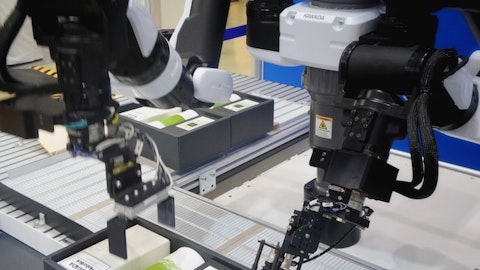Angus Pacala: Sure. Thanks for the question, Brian. There are many corollaries in terms of time to market between the industrial market and the automotive market. But the rollout of the technology can happen more linearly which allows for industrial customers to kind of track to a more expected time line for the rollout of the technology. So, what we’ve seen is that by engaging with a large number of industrial players, we’re able to identify the industrial companies that can create a set of parameters that allows them to get their product out quickly and really invest in those players. And each and every year, a new set of industrial companies has a mature enough product that they can bring that to market and start to expand their purchasing with us and bring expanding volumes to market.
And so, that’s much more of a predictable cadence because there are a lot of customers in this space and because industrial players are able to constrain the problem that they’re embarking on much better than the automotive players, where it’s kind of all or nothing. And so, that’s led to a much more predictable business for Ouster. There are still many benefits for Ouster in the industrial space versus consumer automotive in terms of gross margins and ASP expectations. And that really just falls to the type of end customer, it’s not a consumer, generally industrial players are selling B2B to other industrial players and the equipment costs that they’re putting our lidar on are much more expensive. So, multimillion dollar pieces of industrial machinery, construction equipment, mining equipment can tolerate a higher price point, higher ASPs than the consumer automotive industry.
So, that just has led to again, it’s kind of reflected in our results, our ASP resilience over the last year and the solid kind of quarter-on-quarter revenue build that we’ve shown for four quarters now since the merger is really because of the dynamics I just laid out in the industrial sector.
Brian Dobson: Excellent. Thanks very much.
Operator: Your next question comes from the line of Kevin Cassidy with Rosenblatt Securities. Your line is open.
Kevin Cassidy: Yes, thanks for taking my question and congratulations on the great results and great progress. But along those lines on the gross margin you’re at 35%. So, you’re getting very close to your target. But can you say what the moving parts are for potential improvement from here? Is it lower material costs as revenues or units increase or is software the larger component of lifting gross margin?
Mark Weinswig: Yes. So, I’ll hit on the couple of items that led to the kind of improvements over the last couple of quarters and I’m sure Angus will want to talk a little bit about kind of the software opportunity. After we did the merger, the most important thing was really reducing the cost structure of the organization. The operations and manufacturing group put a huge effort in terms of that. We’re able to move almost all the Velodyne sensors overseas in the first few months and now we’re actually 100% outsourced over to our partner over in Thailand. That’s led to a significant reduction in our overall cost. We’ve also seen a big increase in our volumes that’s also given us additional opportunities in terms of operating leverage.
So, those are the two main factors that we’ve seen really in the last since the beginning of this year. And then, obviously the release of the REV7 sensor, which has just, it’s the most performance sensor in the market. We have a higher ASP, a lot of customer interest in that, and that’s really led to us to see overall improvements in our gross margins. Now going forward, I’ll leave it to Angus to kind of walk through some of the go forward opportunities from the software side.
Angus Pacala: Yes, absolutely. And I would highlight that there’s further opportunity to produce unique features and capabilities in our next generation of OS sensors. So, REV7 has shown that kind of immense success that we can tap by iterating on our silicon and driving new capability in the lidar hardware. We’re going to continue that with the L4 chip and the next generation of OS and DF sensors. But on the software side, with the solutions business that we’ve developed in the last year with Ouster Gemini and Blue City, we see an opportunity to expand our margin in that business and potentially expand that the rate of adoption of lidar technology for the smart infrastructure use cases as kind of an added benefit to the software play that we’re making there.
So, you can imagine that the majority of customers that are buying Ouster lidar have some significant investment in software that they are making to build a complete solution. And that investment is something that we are now able to sell and provide value ourselves through these complete solutions that we’re providing in Smart Infrastructure. So, I think that there’s more to come there on the margin side.
Kevin Cassidy: Okay, great. Yes. I was going to that question with the L4 if you expected ASPs to go up further and maybe as long as I’m asking the question, how do you handle software revenue? Is it going to be folded into the average selling price amortized over the number of sensors or is it going to be a separate line item?
Mark Weinswig: Yes, it’s a great question, and we are as software does grow, you will start to see that we’ll start to break out more information on that and that’ll probably start to happen over the next year or so. But we are really excited about the amount of deployments that we’ve already done to date and what that looks like. We are still refining the model as we work with customers and that will change over time as more customers come into the fold and start seeing the opportunity for the Ouster product line.
Angus Pacala: Yes. And I would add, I mean the majority of our software revenue is a subscription based software business. So, we’re already seeing customer willingness to adopt that model into the Smart Infrastructure sector.



